Research on the Spatiotemporal Characteristics and Concentration Prediction Model of PM2.5 during Winter in Jiangbei New District, Nanjing, China
Abstract
1. Introduction
2. Materials and Methods
2.1. Research Objects
2.2. Data Acquisition and Preprocessing
2.3. Air Quality Level
2.4. The RNN Model of GRU
2.4.1. GRU Neural Network
2.4.2. Data Set
2.4.3. PM2.5 Concentration Prediction Model Based on GRU Neural Network
2.4.4. Evaluation Index
2.5. The Model of Support Vector Regression
3. Results and Discussion
3.1. PM2.5 Spatiotemporal Characteristics
3.2. Model Prediction Results
4. Conclusions
Author Contributions
Funding
Institutional Review Board Statement
Informed Consent Statement
Data Availability Statement
Acknowledgments
Conflicts of Interest
References
- Ministry of Ecology and Environment of China. China’s Environmental State Communique. 2018. Available online: https://www.mee.gov.cn/xxgk2018/xxgk/xxgk15/201912/t20191231_754139.html (accessed on 15 July 2022).
- He, K.; Yang, F.; Ma, Y.; Zhang, Q.; Yao, X.; Chan, C.K.; Cadle, S.; Chan, T.; Mulawa, P. The characteristics of PM2.5 in Beijing, China. Atmos. Environ. 2001, 35, 4959–4970. [Google Scholar] [CrossRef]
- Pui, D.Y.H.; Chen, S.C.; Zuo, Z. PM2.5 in China: Measurements, sources, visibility and health effects, and mitigation. Particuology 2014, 13, 1–26. [Google Scholar] [CrossRef]
- Kampa, M.; Castanas, E. Human health effects of air pollution. Environ. Pollut. 2008, 151, 362–367. [Google Scholar] [CrossRef] [PubMed]
- Dockery, D. Effects of inhalable particles on respiratory health of children. Am. Rev. Respir. Dis. 1989, 139, 587–594. [Google Scholar] [CrossRef] [PubMed]
- Zhao, C.; Wang, Y.; Su, Z.; Pu, W.; Niu, M.; Song, S.; Wei, L.; Ding, Y.; Xu, L.; Tian, M.; et al. Respiratory exposure to PM2.5 soluble extract disrupts mucosal barrier function and promotes the development of experimental asthma. Sci. Total Environ. 2020, 730, 139–145. [Google Scholar] [CrossRef]
- Zhu, G.; Hu, W.; Liu, Y.; Cao, J.; Ma, Z.; Deng, Y.; Sabel, C.E.; Wang, H. Health burdens of ambient PM2.5 pollution across Chinese cities during 2006–2015. J. Environ. Manag. 2019, 243, 250–256. [Google Scholar] [CrossRef]
- Ding, S.; Xu, N.; Ye, J.; Ye, J.; Zhou, W.; Zhang, X. Estimating Chinese energy-related CO2 emissions by employing a novel discrete grey prediction model. J. Clean. Prod. 2020, 259, 120793. [Google Scholar] [CrossRef]
- Pozza, S.A.; Lima, E.P. Time series analysis of PM2.5 and PM10-2.5 mass concentration in the city of Sao Carlos, Brazil. Int. J. Environ. Pollut. 2010, 41, 90–108. [Google Scholar] [CrossRef]
- Dimitriou, K.; Kassomenos, P. A study on the reconstitution of daily PM10 and PM2.5 levels in Paris with a multivariate linear regression model. Atmos. Environ. 2014, 98, 648–654. [Google Scholar] [CrossRef]
- Christakos, G.; Serre, M.L. BME analysis of spatiotemporal particulate matter distributions in North Carolina. Atmos. Environ. 2000, 34, 3393–3406. [Google Scholar] [CrossRef]
- Grivas, G.; Chaloulakou, A. Artificial neural network models for prediction of PM10 hourly concentrations, in the Greater Area of Athens, Greece. Atmos. Environ. 2006, 40, 1216–1229. [Google Scholar] [CrossRef]
- Perez, P.; Gramsch, E. Forecasting hourly PM2.5 in Santiago de Chile with emphasis on night episodes. Atmos. Environ. 2016, 124, 22–27. [Google Scholar] [CrossRef]
- Chen, Y.G. Prediction algorithm of PM2.5 mass concentration based on adaptive BP neural network. Computing 2018, 100, 825–838. [Google Scholar] [CrossRef]
- Prakash, A.; Kumar, U.; Kumar, K.; Jain, V.K. A wavelet-based neural network model to predict ambient air pollutants’ concentration. Environ. Modeling Assess. 2011, 16, 503–517. [Google Scholar] [CrossRef]
- Huang, C.J.; Kuo, P.H. A deep CNN-LSTM model for particulate matter (PM2.5) forecasting in smart cities. Sensors 2018, 18, 2220. [Google Scholar] [CrossRef] [PubMed]
- Cho, K.; Merrienboer, B.V.; Gulcehre, C.; Badanau, D.; Bougares, F.; Schwenk, H.; Bengio, Y. Learning phrase representations using RNN encoder-decoder for statistical machine translation. arXiv 2014, arXiv:1406.1078. [Google Scholar]
- Hochreiter, S.; Schmidhuber, J. Long short-term memory. Neural Computation 1997, 9, 1735–1780. [Google Scholar] [CrossRef]
- Gers, F.A.; Schmidhuber, J.; Cummins, F. Learning to forget continual prediction with LSTM. Neural Comput. 2000, 12, 2451–2471. [Google Scholar] [CrossRef]
- Zou, X.; Qian, Y.; Zhang, S. Spatiotemporal variations of PM2.5 concentration and relationship with other criteria pollutants in Nanjing, China. Nat. Environ. Pollut. Technol. 2018, 17, 499–505. [Google Scholar]
- Zhang, S.; Lin, M.; Zou, X.; Steven, S.; Zhang, W.; Zhang, X.; Guo, Z. LSTM-based air quality predicted model for large cities in China. Nat. Environ. Pollut. Technol. 2020, 19, 229–236. [Google Scholar]
- Ji, H.; Wang, Q.; Yu, Y.; Lu, Y. How have the characteristics of air quality in a typical large Chinese city changed between 2011 and 2017. Air Qual. Atmos. Health 2019, 12, 401–410. [Google Scholar] [CrossRef]
- Kingma, D.; Ba, J. Adam: A method for stochastic optimization. arXiv 2015, arXiv:1412.6980v9, 1–15. [Google Scholar]
- Bottou, L. Large-scale machine learning with stochastic gradient descent. In Proceedings of the 19th International Conference on Computational Statistics (COMPSTAT'2010), Paris, France, 22–27 August 2010; pp. 177–186. [Google Scholar]
- Ketkar, N. Introduction to PyTorch; Apress: Berkeley, CA, USA, 2017; Chapter 12; pp. 195–208. [Google Scholar]
- Quang, D.; Guan, Y.; Parker, S.C.J. YAMDA: Thousandfold speedup of EM-based motif discovery using deep learning libraries and GPU. Bioinformatics 2018, 34, 3578–3580. [Google Scholar] [CrossRef] [PubMed]
- Sedgwick, P. Pearson’s correlation coefficient. BMJ 2012, 345, e4483. [Google Scholar] [CrossRef]
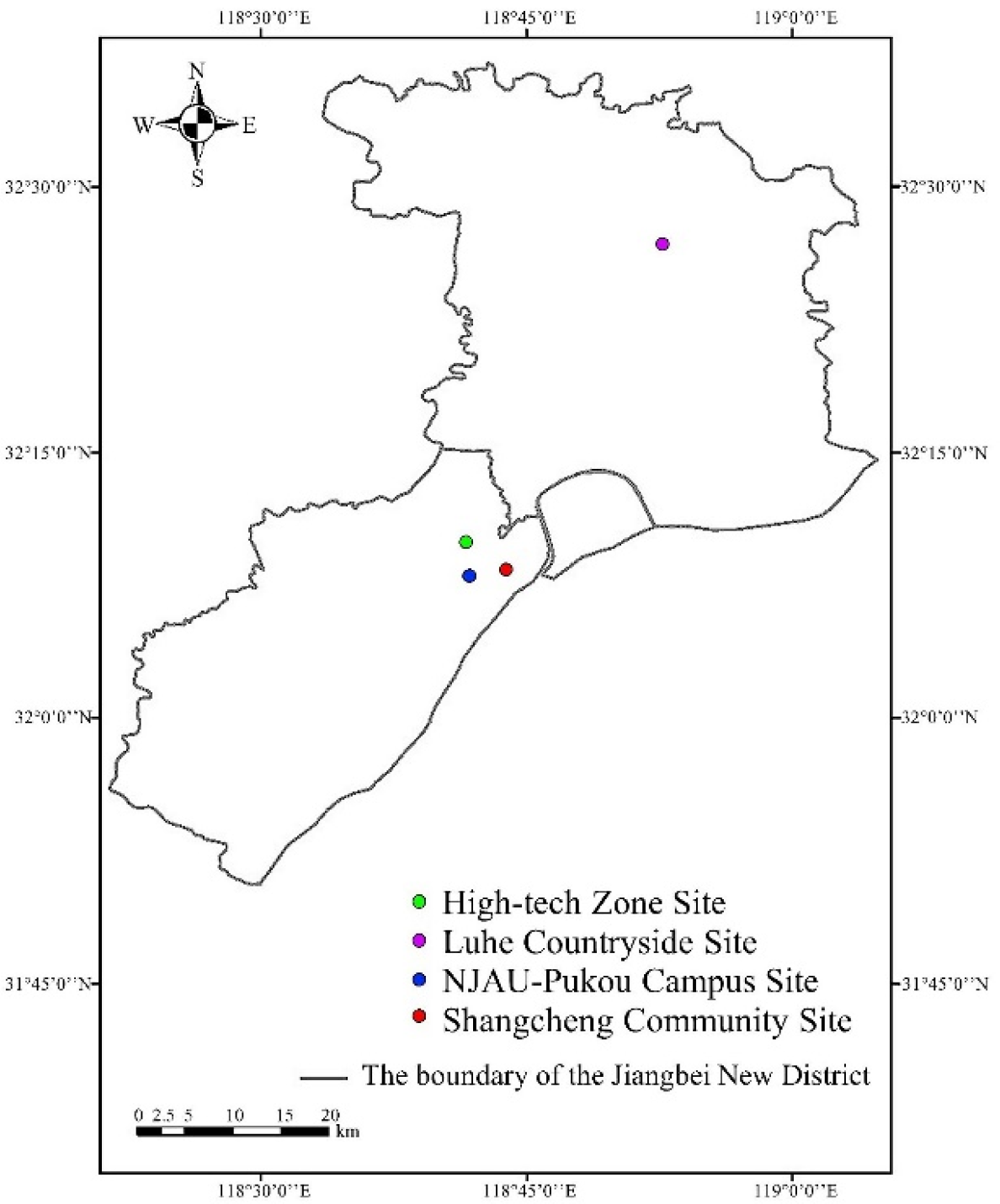


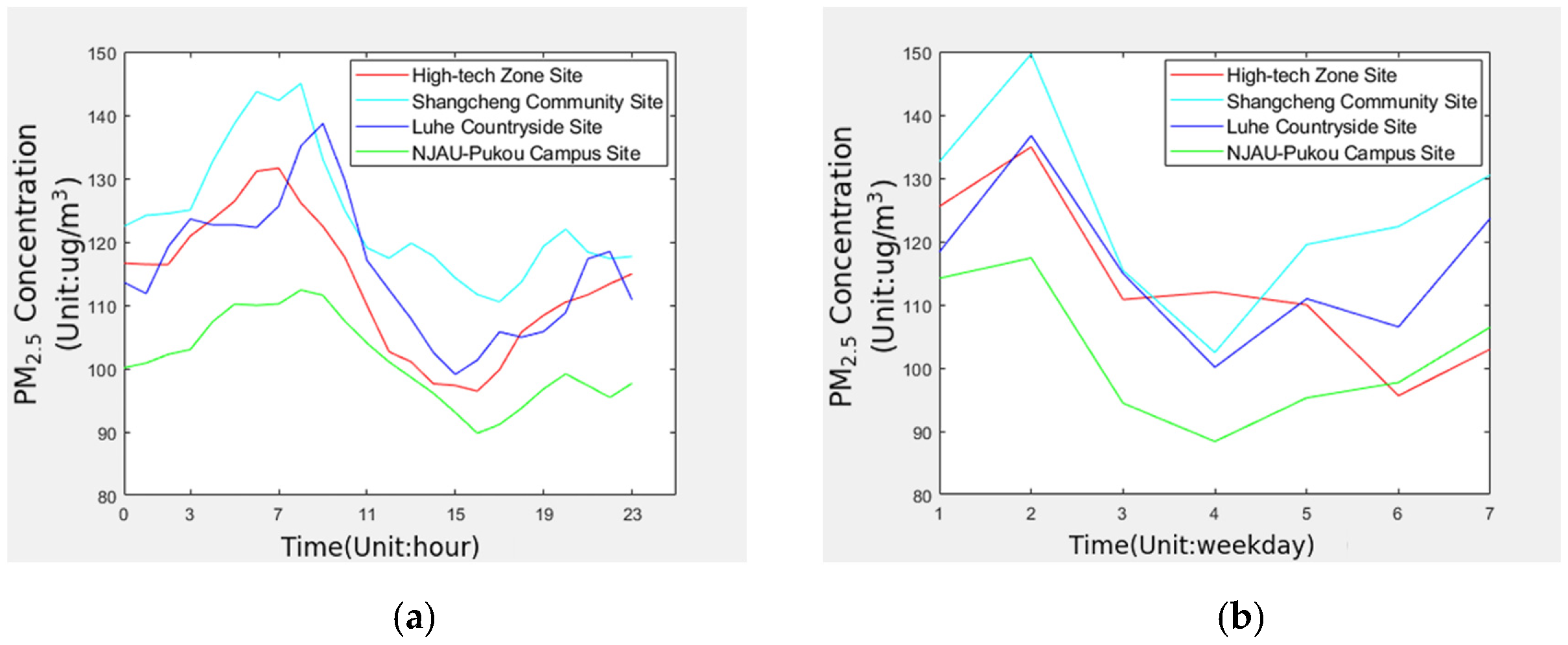
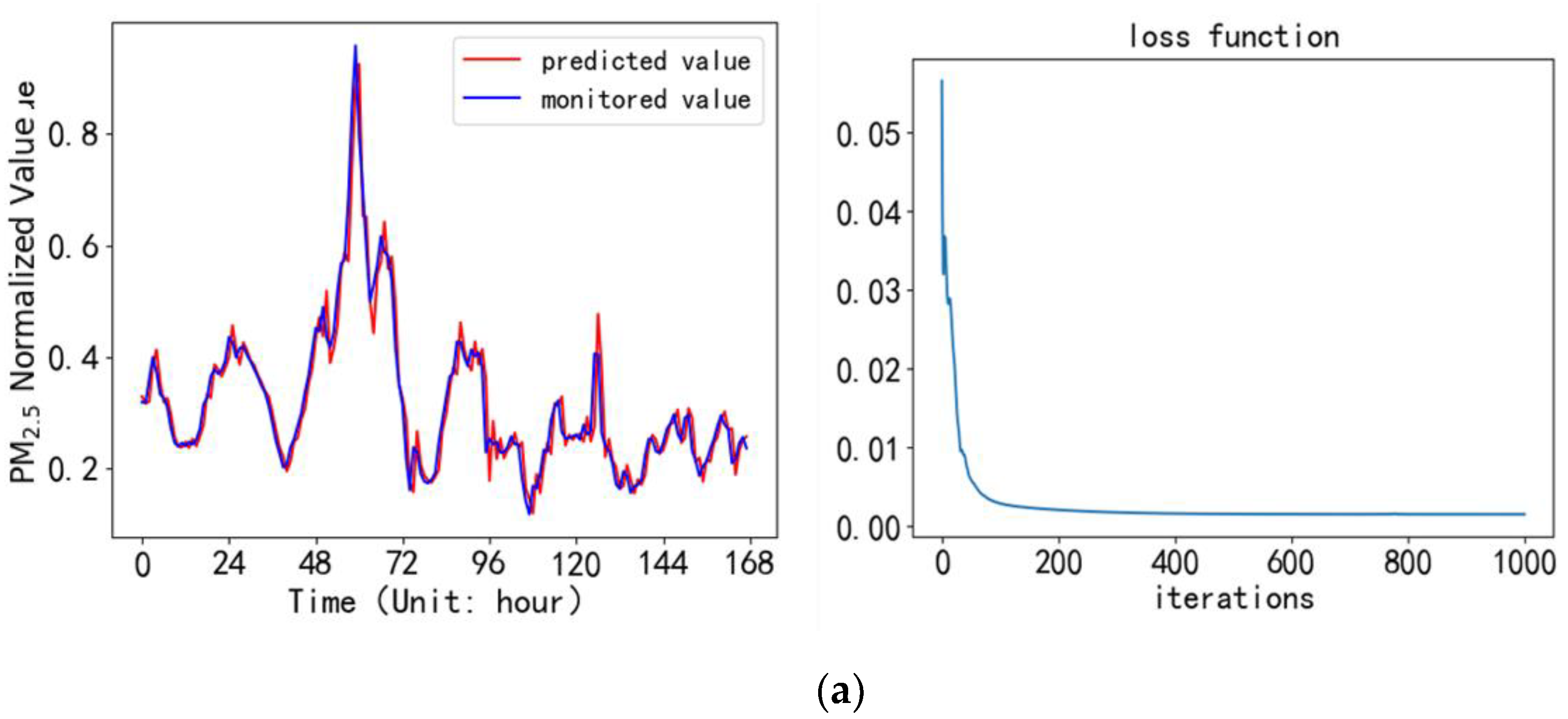
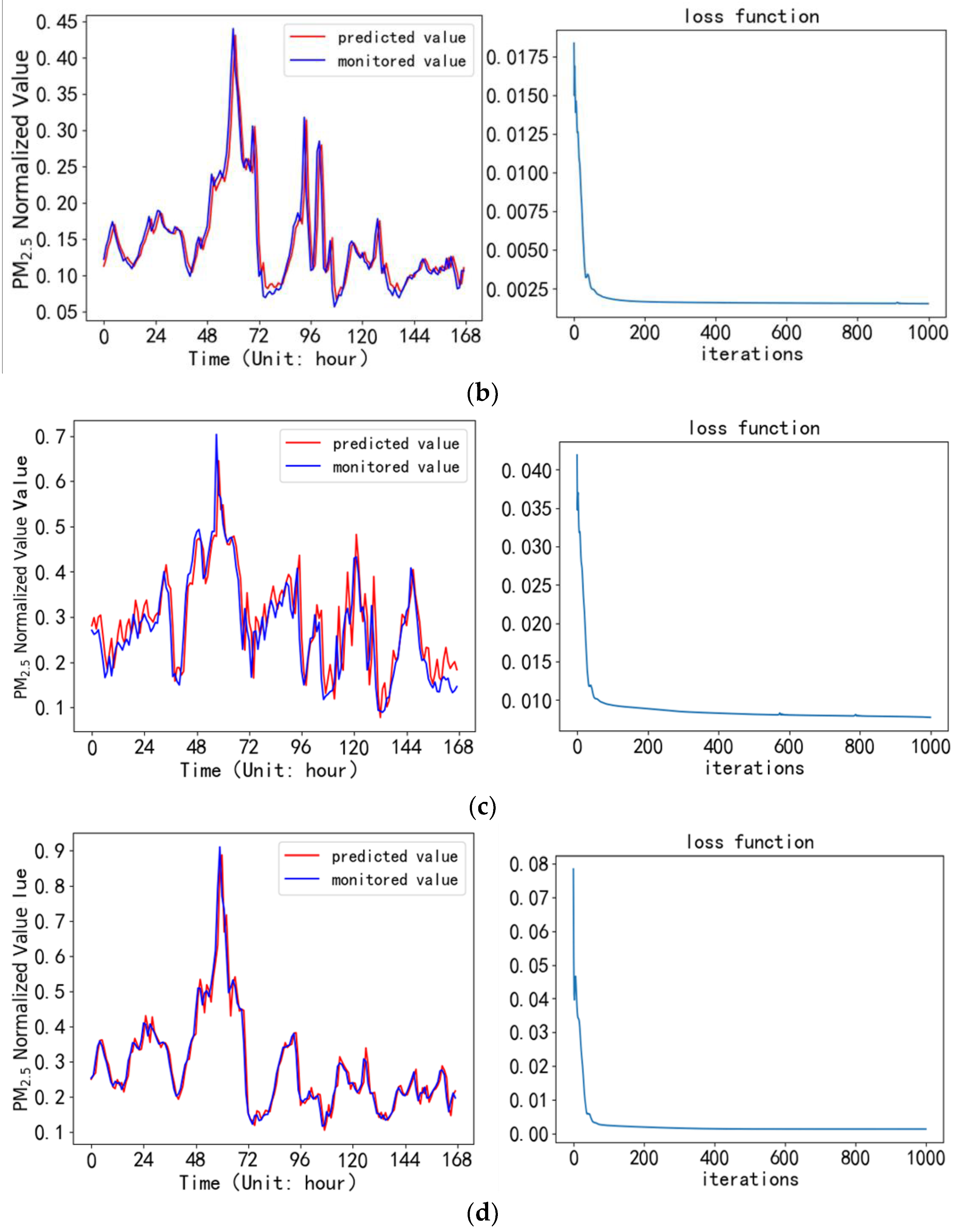
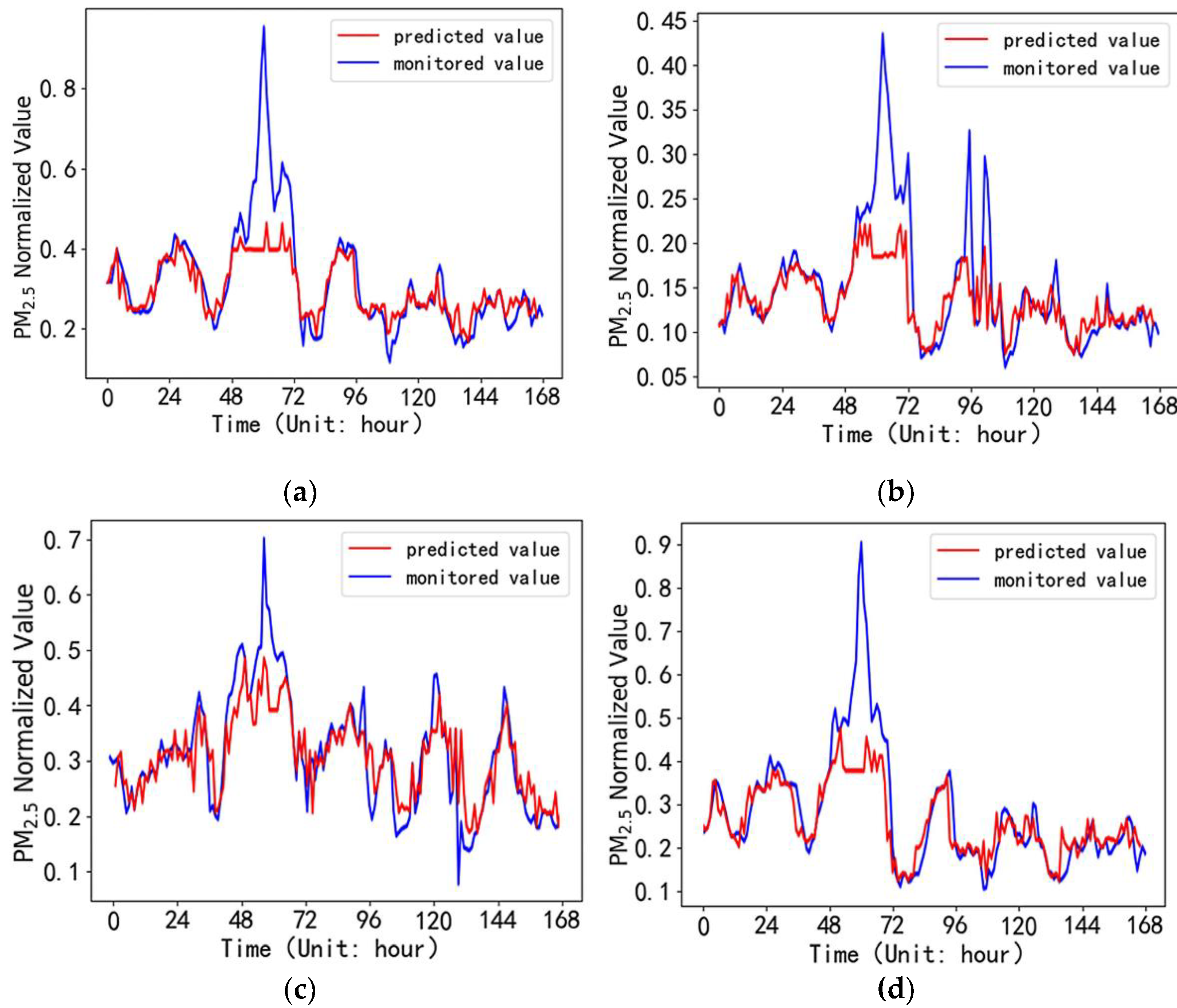
| Index | Accuracy | Resolution | Range |
|---|---|---|---|
| PM2.5 | 1 | 0~1000(ug/m3) | |
| PM10 | 1 | 0~1000(ug/m3) | |
| Temperature | 0.1 | −40~+80 (°C) | |
| Relative Humidity | 0.1 | 0~100 (%) |
| Site | Data Volume | Maximum Value | Minimum Value | Mean Value | Standard Deviation |
|---|---|---|---|---|---|
| High-tech Zone Site | 62,084 | 453 | 5 | 113 | 61 |
| Shangcheng Community Site | 83,872 | 499 | 3 | 124 | 76 |
| Luhe Community Site | 65,006 | 499 | 9 | 116 | 65 |
| NJAU-Pukou Campus Site | 83,055 | 397 | 3 | 101 | 59 |
| Air Quality Grades | Air Pollution Index (API) | Impact of Human Life |
|---|---|---|
| Excellent | 0–50 | Normal activities |
| Good | 51–100 | Normal activities |
| Light pollution | 101–200 | Susceptible populations have mild exacerbations, and healthy people experience irritation symptoms. |
| Moderate pollution | 201–300 | Symptoms of heart disease and lung disease patients are significantly increased, and healthy people’s exercise tolerance decreases. |
| Severe pollution | More than 301 | Healthy people have obvious symptoms and certain diseases. |
| Correlation Strength | |
|---|---|
| 0.8–1.0 | Highly relevant |
| 0.6–0.8 | Strong correlation |
| 0.4–0.6 | Moderate correlation |
| 0.2–0.4 | Weak correlation |
| 0.0–0.2 | Very weak correlation or no correlation |
| Site | MRE (%) | RMSE (ug/m3) | Pearson Correlation Coefficient |
|---|---|---|---|
| High-tech Zone Site | 9.03 | 13.5484 | 0.958 |
| Shangcheng Community Site | 11.10 | 16.9316 | 0.928 |
| Luhe Countryside Site | 11.19 | 17.0378 | 0.907 |
| NJAU-Pukou Campus Site | 7.85 | 9.6049 | 0.970 |
| Site | MRE (%) | RMSE (ug/m3) | Pearson Correlation Coefficient |
|---|---|---|---|
| High-tech Zone Site | 12.51 | 30.2363 | 0.805 |
| Shangcheng Community Site | 32.94 | 13.5800 | 0.761 |
| Luhe Countryside Site | 20.07 | 18.0691 | 0.872 |
| NJAU-Pukou Campus Site | 24.56 | 12.7100 | 0.837 |
Publisher’s Note: MDPI stays neutral with regard to jurisdictional claims in published maps and institutional affiliations. |
© 2022 by the authors. Licensee MDPI, Basel, Switzerland. This article is an open access article distributed under the terms and conditions of the Creative Commons Attribution (CC BY) license (https://creativecommons.org/licenses/by/4.0/).
Share and Cite
Li, Y.; Zhu, Z.; Xin, C.; Chen, Z.; Wang, S.; Liang, Z.; Zou, X. Research on the Spatiotemporal Characteristics and Concentration Prediction Model of PM2.5 during Winter in Jiangbei New District, Nanjing, China. Atmosphere 2022, 13, 1542. https://doi.org/10.3390/atmos13101542
Li Y, Zhu Z, Xin C, Chen Z, Wang S, Liang Z, Zou X. Research on the Spatiotemporal Characteristics and Concentration Prediction Model of PM2.5 during Winter in Jiangbei New District, Nanjing, China. Atmosphere. 2022; 13(10):1542. https://doi.org/10.3390/atmos13101542
Chicago/Turabian StyleLi, Yuanxi, Zhongzheng Zhu, Chengrui Xin, Zhilong Chen, Sunyuan Wang, Zhenyu Liang, and Xiuguo Zou. 2022. "Research on the Spatiotemporal Characteristics and Concentration Prediction Model of PM2.5 during Winter in Jiangbei New District, Nanjing, China" Atmosphere 13, no. 10: 1542. https://doi.org/10.3390/atmos13101542
APA StyleLi, Y., Zhu, Z., Xin, C., Chen, Z., Wang, S., Liang, Z., & Zou, X. (2022). Research on the Spatiotemporal Characteristics and Concentration Prediction Model of PM2.5 during Winter in Jiangbei New District, Nanjing, China. Atmosphere, 13(10), 1542. https://doi.org/10.3390/atmos13101542








